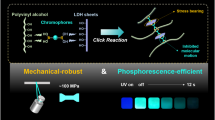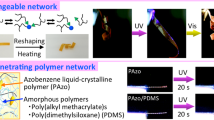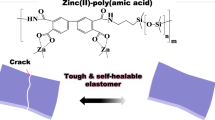Abstract
Although development of soft and stretchable materials exhibiting semiconducting functions, such as luminescent or electronic properties, has received growing interest, development of intrinsically self-healing semiconducting materials remains a challenge. In this study, covalent and hydrogen-bonding architectures were used to construct polyisoprene (PI)-based rubber containing luminescent poly[2,7-(9,9-dioctylfluorene)] (PF), and the material exhibited elastic behavior and spontaneous healing. The first demonstration of an engineered hard–soft multiphase, well-dispersed polymer thin film was conducted, wherein the soft phase backbone containing dynamic hydrogen bonds and rubber-like moieties imparted resistance against damage due to repeated stretching, while the hard phase comprising aggregates of rigid PF branches imparted luminescence. Under intense mechanical stress, both the bulk and thin-film states of the crosslinked PF0.16-co-PI0.37-co-PBACO0.47 impressively presented typical elastic performance. Owing to the dynamic nature of the hydrogen bonds within the crosslinked polyisoprene copolymer, the bulk and thin film states exhibited good self-healing and an 83% recovery efficiency following treatment for 24 h at room temperature. This strategy is potentially useful for fabrication of fully flexible electronics with good mechanical properties and many functionalities.
This is a preview of subscription content, access via your institution
Access options
Subscribe to this journal
Receive 12 print issues and online access
$259.00 per year
only $21.58 per issue
Buy this article
- Purchase on Springer Link
- Instant access to full article PDF
Prices may be subject to local taxes which are calculated during checkout






Similar content being viewed by others
References
Gao W, Ota H, Kiriya D, Takei K, Javey A. Flexible electronics toward wearable sensing. Acc Chem Res. 2019;52:523–33.
Wang P, Hu M, Wang H, Chen Z, Feng Y, Wang J, et al. The evolution of flexible electronics: from nature, beyond nature, and to nature. Adv Sci. 2020;7:2001116.
Tran H, Feig VR, Liu K, Wu H-C, Chen R, Xu J, et al. Stretchable and fully degradable semiconductors for transient electronics. ACS Cent Sci. 2019;5:1884–91.
Mun J, Ochiai Y, Wang W, Zheng Y, Zheng Y-Q, Wu H-C, et al. A design strategy for high mobility stretchable polymer semiconductors. Nat Commun. 2021;12:3572.
Tien H-C, Huang Y-W, Chiu Y-C, Cheng Y-H, Chueh C-C, Lee W-Y. Intrinsically stretchable polymer semiconductors: molecular design, processing and device applications. J Mater Chem C. 2021;9:2660–84.
Choi D, Kim H, Persson N, Chu P-H, Chang M, Kang J-H, et al. Elastomer–polymer semiconductor blends for high-performance stretchable charge transport networks. Chem Mater. 2016;28:1196–204.
Wang GJN, Shaw L, Xu J, Kurosawa T, Schroeder BC, Oh JY, et al. Inducing elasticity through oligo-siloxane crosslinks for intrinsically stretchable semiconducting polymers. Adv Func Mater 2016;26:7254–62.
Kim J-H, Noh J, Choi H, Lee J-Y, Kim T-S. Mechanical properties of polymer–fullerene bulk heterojunction films: role of nanomorphology of composite films. Chem Mater. 2017;29:3954–61.
Wang G-JN, Zheng Y, Zhang S, Kang J, Wu H-C, Gasperini A, et al. Tuning the cross-linker crystallinity of a stretchable polymer semiconductor. Chem Mater. 2019;31:6465–75.
Au-Duong A-N, Wu C-C, Li Y-T, Huang Y-S, Cai H-Y, Jo Hai I, et al. Synthetic concept of intrinsically elastic luminescent polyfluorene-based copolymers via RAFT polymerization. Macromolecules. 2020;53:4030–7.
Chen D, Wang D, Yang Y, Huang Q, Zhu S, Zheng Z. Self-healing materials for next-generation energy harvesting and storage devices. Adv Energy Mater. 2017;7:1700890.
Xie T, Vogt BD. A virtual special issue on self-healing materials. ACS Appl Mater Interfac. 2020;12:49277–80.
Oh JY, Rondeau-Gagné S, Chiu Y-C, Chortos A, Lissel F, Wang G-JN, et al. Intrinsically stretchable and healable semiconducting polymer for organic transistors. Nature. 2016;539:411–5.
Oh Jin Y, Son D, Katsumata T, Lee Y, Kim Y, Lopez J, et al. Stretchable self-healable semiconducting polymer film for active-matrix strain-sensing array. Sci Adv. 2019;5:eaav3097.
Chen Y, Kushner AM, Williams GA, Guan Z. Multiphase design of autonomic self-healing thermoplastic elastomers. Nat Chem. 2012;4:467–72.
Hou S, Yu J, Zhuang X, Li D, Liu Y, Gao Z, et al. Phase separation of P3HT/PMMA blend film for forming semiconducting and dielectric layers in organic thin-film transistors for high-sensitivity NO2 detection. ACS Appl Mater Interfac. 2019;11:44521–7.
Zhang M, Cui Z, Brinson CL. Mechanical properties of hard–soft block copolymers calculated from coarse-grained molecular dynamics models. J Polym Sci Part B: Polym Phys. 2018;56:1552–66.
Shi W, Lynd NA, Montarnal D, Luo Y, Fredrickson GH, Kramer EJ, et al. Toward strong thermoplastic elastomers with asymmetric miktoarm block copolymer architectures. Macromolecules. 2014;47:2037–43.
Kato H, Nakatsubo F, Abe K, Yano H. Crosslinking via sulfur vulcanization of natural rubber and cellulose nanofibers incorporating unsaturated fatty acids. RSC Adv. 2015;5:29814–9.
Flory PJ, Rabjohn N, Shaffer MC. Dependence of elastic properties of vulcanized rubber on the degree of cross linking. J Polym Sci. 1949;4:225–45.
Marsitzky D, Klapper M, Müllen K. End-functionalization of poly(2,7-fluorene): a key step toward novel luminescent rod−coil block copolymers. Macromolecules. 1999;32:8685–8.
Lin C-H, Tung Y-C, Ruokolainen J, Mezzenga R, Chen W-C.Poly[2,7-(9,9-dihexylfluorene)]-block-poly(2-vinylpyridine) rod−coil and coil−rod−coil block copolymers: Synthesis, morphology and photophysical properties in methanol/THF mixed solvents.Macromolecules.2008;41:8759–69.
Tian YQ, Chen CY, Yip HL, Wu WC, Chen WC, Jen AKY. Synthesis, nanostructure, functionality, and application of polyfluorene-block-poly(N-isopropylacrylamide)s. Macromolecules. 2010;43:282–91.
Widmaier JM, Meyer GC. Glass transition temperature of anionic polyisoprene. Macromolecules. 1981;14:450–2.
Berglund CA, McKay KW. Viscoelastic properties of a styrene-isoprene-styrene triblock copolymer and its blends with polyisoprene homopolymer and styrene-isoprene diblock copolymer. Polym Eng Sci. 1993;33:1195–203.
Zeng G, Yu W-L, Chua S-J, Huang W. Spectral and thermal spectral stability study for fluorene-based conjugated polymers. Macromolecules. 2002;35:6907–14.
Buenviaje C, Ge S, Rafailovich M, Sokolov J, Drake JM, Overney RM. Confined flow in polymer films at interfaces. Langmuir. 1999;15:6446–50.
Surin M, Marsitzky D, Grimsdale AC, Müllen K, Lazzaroni R, Leclère P. Microscopic morphology of polyfluorene–poly(ethylene oxide) block copolymers: Influence of the block ratio. Adv Func Mater. 2004;14:708–15.
Wang G-JN, Zheng Y, Zhang S, Kang J, Wu H-C, Gasperini A, et al. Tuning the cross-linker crystallinity of a stretchable polymer semiconductor. Chem Mater. 2018;31:6465–75.
Hsieh H-C, Hung C-C, Watanabe K, Chen J-Y, Chiu Y-C, Isono T, et al. Unraveling the stress effects on the optical properties of stretchable rod-coil polyfluorene-poly(n-butyl acrylate) block copolymer thin films. Polym Chem. 2018;9:3820–31.
Huang X, Nakagawa S, Houjou H, Yoshie N. Insights into the role of hydrogen bonds on the mechanical properties of polymer networks. Macromolecules. 2021;54:4070–80.
Kjøniksen A-L, Nyström B. Effects of polymer concentration and cross-linking density on rheology of chemically cross-linked poly(vinyl alcohol) near the gelation threshold. Macromolecules. 1996;29:5215–22.
Miwa Y, Kurachi J, Kohbara Y, Kutsumizu SJCC. Dynamic ionic crosslinks enable high strength and ultrastretchability in a single elastomer. Commun Chem. 2018;5:1–8.
Hornat CC, Urban MW. Entropy and interfacial energy driven self-healable polymers. Nat Commun. 2020;11:1–9.
Eom Y, Kim S-M, Lee M, Jeon H, Park J, Lee ES, et al. Mechano-responsive hydrogen-bonding array of thermoplastic polyurethane elastomer captures both strength and self-healing. Nat Commun. 2021;12:1–11.
Zhang S, Cheng YH, Galuska L, Roy A, Lorenz M, Chen B, et al. Tacky elastomers to enable tear‐resistant and autonomous self‐healing semiconductor composites. Adv Func Mater. 2020;30:2000663.
Acknowledgements
This work was supported by the Ministry of Science and Technology, Taiwan (Contracts: MOST 110-2634-F-002-043 and 110-2221-E-011-009). Y-CC received financial support from the “Advanced Research Center for Green Materials Science and Technology” of The Featured Area Research Center Program within the framework of the Higher Education Sprout Project by the Ministry of Education (No. 110L9006). All authors acknowledge Syntrol Industrial Co. Ltd. (Taipei, Taiwan) and Hitachi High-Tech Technical Support Team (Japan) for their help with the AFM experiments performed with a Hitachi High-Tech Vacuum type AFM5300E with SIS-Access & SIS-QuantiMech.
Author information
Authors and Affiliations
Corresponding author
Ethics declarations
Conflict of interest
The authors declare no competing interests.
Additional information
Publisher’s note Springer Nature remains neutral with regard to jurisdictional claims in published maps and institutional affiliations.
Supplementary information
Rights and permissions
About this article
Cite this article
Au-Duong, AN., Hsu, YC., Chen, KL. et al. Intrinsically elastic and self-healing luminescent polyisoprene copolymers formed via covalent bonding and hydrogen bonding design. Polym J 54, 1331–1343 (2022). https://doi.org/10.1038/s41428-022-00683-3
Received:
Revised:
Accepted:
Published:
Issue Date:
DOI: https://doi.org/10.1038/s41428-022-00683-3



